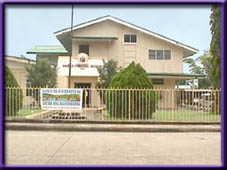| MUNICIPALITY OF DUEÑAS |
|
| MUNICIPALITY OF DUEÑAS |
|
Mayor:
Pio B. Pama Jr.
Vice Mayor:
Pablo L. Landar
[
brief history ] [ accessibility
] [ resource profile ]
[ demographic
profile ] [ tourist facilities ]
[ infrastructure and utilities]
BRIEF
HISTORY
 The
documented historical account of Dueñas started when Miguel Lopez
de Legaspi sent his men to Panay in 1569 and made the island as the second
Spanish settlement in the Philippines. Legaspi then assigned an encomienda
to Diego Lopez de Valdepenas covering Sibucao, a district of Dueñas
in 1571. Dueñas was founded in 1590 with the name of Sumandig. Sumandig
was an annex of Sibucao. In this place the people practiced pagan rituals
and idol worshipping. A certain god named diwata Banog, believed to delay
or impede travelers, was offered rituals and dances as peace offerings.
A certain folk hero named Labaodunggon was also hero-worshipped by the
folks. He was the husband of Unay Tanayon, the daughter of Datu Paiburong
and his wife Pamalaon. In 1598, the Agustinian took back Sibucao where
Fr. Juan de Villamayor was assigned as the first Parish of Dueñas
in May 7, 1599. Four years later it was joined to Dumangas (1603) and enjoyed
independence two years after (1605). In 1608, it was transferred to Laglag
(now Pader, Dueñas). It had only five barrios, namely: Sibucao and
sumandig in the Lowlands; and Misi, Camantungan and Malonor in the upland.
The
documented historical account of Dueñas started when Miguel Lopez
de Legaspi sent his men to Panay in 1569 and made the island as the second
Spanish settlement in the Philippines. Legaspi then assigned an encomienda
to Diego Lopez de Valdepenas covering Sibucao, a district of Dueñas
in 1571. Dueñas was founded in 1590 with the name of Sumandig. Sumandig
was an annex of Sibucao. In this place the people practiced pagan rituals
and idol worshipping. A certain god named diwata Banog, believed to delay
or impede travelers, was offered rituals and dances as peace offerings.
A certain folk hero named Labaodunggon was also hero-worshipped by the
folks. He was the husband of Unay Tanayon, the daughter of Datu Paiburong
and his wife Pamalaon. In 1598, the Agustinian took back Sibucao where
Fr. Juan de Villamayor was assigned as the first Parish of Dueñas
in May 7, 1599. Four years later it was joined to Dumangas (1603) and enjoyed
independence two years after (1605). In 1608, it was transferred to Laglag
(now Pader, Dueñas). It had only five barrios, namely: Sibucao and
sumandig in the Lowlands; and Misi, Camantungan and Malonor in the upland.
As the conversion of the natives in the lowlands were going on, those natives who refused to be converted went upland and continued their pagan rituals/religious practices. A noted sorcerer named Tapar used to go around the town as babaylan (quack doctor) and convince people to worship idols and practices fornication. This was during the term of Fr. Francisco de Mesa as Parish Priest of Laglag (1659-1663). When the priest learned the unhappy condition in which souls of parishioners were at stake, he went to the barrio of Malonor, despite of much opposition from some town officials, to persuade Tapar and his followers to go back to the holy faith, only to face his death in the hands of the latter. Two days after, the Spanish soldiers went to the barrio of Malonor to recover and bury the body of the towns first martyr.
Lately, in 1845, Laglag was moved around four (4) kilometers eastward with the name of Dueñas, in memory of the birthplace (Dueñas, Palencia, Spain) of Fr. Florencio Martin, OSA who authored the transfer. The word "Dueñas" or "Dueña" (sing) is derived from the Latin word domna or domina, which means landlady or madam who, has dominion over a certain or estates.
Signs that early or pre-Hispanic Civilization or settlement existed in Dueñas are also proven by the relics found in Tinocuan and Pader, formerly called Laglag, ceramic wares found in these areas are characterized by technical perfection of a simple feldspathic glaze of Song ceramics of Sung Dynasty (960-1279), and the blue and white resulting from cobalt pigment of Ming Ceramics of Ming Dynasty (13681644). These relics confirm the fact that early trade contacts with the Chinese and Arab Traders had been going on. What is significant about the two areas are their strategic places along the river which were logical points to give birth to civilization or settlement since they are along the river the only means of transportation.
Land Use/Cover
Built-up area 992.1703
hectares
Socialized Housing 5.7875
hectares
Agro-Industrial 51.3607
hectares
Industrial 31.1152 hectares
Park/ Open space and other
recreational area 16.6263 hectares
Easement from rivers and
creeks 28.6263 hectares
Infrastructure and water
bodies 142.9146 hectares h. Agricultural 7,860.0252 hectares
Land Classification Status
Existing Tourism Related Projects
Proposed Tourism Development Projects
Bridges
Post Office 1
Communication Facilities
Bank
Medical Facilities
Schools
[
brief history ] [ accessibility
] [ resource profile ]
[ demographic
profile ] [ tourist facilities ]
[ infrastructure and utilities]